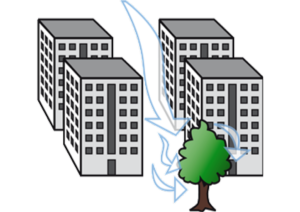Wind Properties
Guidelines for estimating wind properties are based on DIN EN 1991-1-4, a standard designed for evaluating wind loads on buildings.
Referencing wind zones that are defined nationally and the roughness of the adjacent terrain, the average wind speed can be determined starting from a basic wind speed by exponentially increasing wind profiles.
Localised influences must also be taken into account when estimating wind loads. For example, in the built environment, the arrangement of buildings can create tunnel or blast pipe effects that cause the wind to accelerate. Similarly, the wind effect can be reduced by sheltering buildings. This influence can be incorporated into the analysis, for example, through a factor of proximity, which is not part of the wind load standards for buildings.

Conversley, the wind load can be reduced if neighbouring trees collectively absorb the wind energy or distribute it among themselves. Such sheltering effects by other trees can be taken into account, for example, through the incorporation of an exposure factor.


